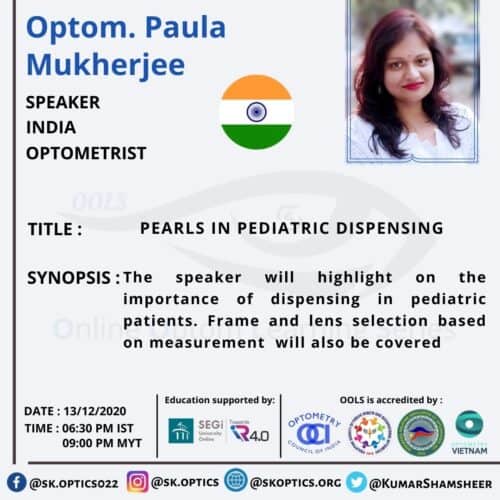
Paula Mukherjee a leading expert in dispensing optometry and an educator, begins by establishing a definition of what is pediatric definition. She uses the general council of Optometry definition: ‘ Dispensing for under 16 years of age‘. We understand the importance of pediatric dispensing and how it differs from adult dispensing.
Since, children are not always very communicative we must always be extremetly careful as any error can cause profound effect on the child’s vision. Mrs. Mukherjee overviews the basics of lenses and frames and how the environment has changed in the modern world. We discuss in depth the key aspects of pediatric dispensing as follows:
- Frame front/frame width
- Eye size
- Bridge position
- Frontal angle
- Temple and joints
- Crest height
- Pantoscopic tilt
- Vertex distance
- Four point touch
Paula Mukherjee, discusses the properties of an ideal frame material for pediatric dispensing. She highlights the need for the material to be lightweight, flexible, hypoallergenic and preferably colourful. We understand the important lens material properties which include,lightweight, high impact resistance, scratch resistance and UV protection. She makes a strong case on how trivex is easily the best choice for children.
She talks about the vision considerations of how to correctly measure the inter -pupillary distance and the vertex distance. We learn the difference between the geometric, pupillary and optical centre and how the matching of pupillary and optical center is a must. We briefly discuss the nuances of dispensing in special cases which include the following:
- Refractive error
- Higher prescription
- Aphakia
- Bifocals
- Progressives
- Facial deformity
- Ptosis
- Crouzans Syndrome
- Teacher Collins Syndrome
- Down’s Syndrome
Lastly, Mrs. Mukherjee, provides some quick tips, things to do and to avoid that will enhance the pediatric dispensing practice. We also learn the importance of an optometrist in dispensing and how this is different from a sales person in an optometry clinic. The session ends with an interactive Q and A session
References
Articles
Soltis, Renee. “The Psychology of Dispensing to children… and their parents.” Review of Optometry, vol. 136, no. 6, 15 June 1999, p. 3
